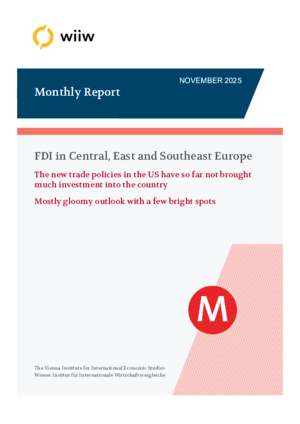Monthly Report No. 11/2025 - FDI in Central, East and Southeast Europe
Doris Hanzl-Weiss and Olga Pindyuk
wiiw Monthly Report No. 11, November 2025
31 pages including 7 Tables and 18 Figures
Current issues accessible exclusively for Members. Free access after an embargo period of six months.
FDI in Central, East and Southeast Europe
- The new trade policies in the US have so far not brought much investment into the country
by Olga Pindyuk
- Mostly gloomy outlook with a few bright spots
by Olga Pindyuk and Doris Hanzl-Weiss
Most countries in CESEE finished 2024 with foreign direct investment stocks (as a share of GDP) lower than in 2021, the year before the start of Russia’s full-scale invasion of Ukraine. Also more recently, CESEE countries have been struggling to maintain their attractiveness to foreign investors, with the number of greenfield projects announced in the region in January-September 2025 reaching its lowest level for six years. China has further strengthened its role as one of the main investors in CESEE, having significantly increased the capital pledged for greenfield projects this year. Kazakhstan has become the main destination for greenfield capital, accounting for 40% of capital pledged to the entire CESEE region, mostly owing to the influx of Chinese investment.
- Forecasts of main economic indicators for Central, East and Southeast Europe for 2025-2027
Reference to wiiw databases: wiiw Annual Database, wiiw Monthly Database, wiiw FDI Database
Keywords: greenfield FDI, import tariffs, FDI inflows, FDI stocks, greenfield FDI, German-Central European supply chain
Countries covered: Austria, CESEE, China, Germany, US
Research Areas: International Trade, Competitiveness and FDI
